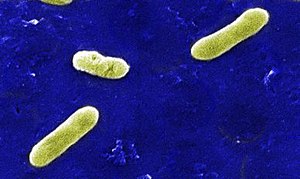Alcaligenaceae
| Alcaligenaceae | ||||||||||||
|---|---|---|---|---|---|---|---|---|---|---|---|---|
 Bordetella bronchiseptica | ||||||||||||
| Systematik | ||||||||||||
| ||||||||||||
| Wissenschaftlicher Name | ||||||||||||
| Alcaligenaceae | ||||||||||||
| De Ley et al. 1986 |
Die Alcaligenaceae sind eine Bakterien-Familie, die zur Ordnung der Burkholderiales gehört. Wie für Proteobakterien typisch, fällt die Gram-Färbung negativ aus.
Merkmale
Fast alle Vertreter der Alcaligenaceae sind aerob und chemoorganotroph. Dementsprechend ist der Stoffwechselweg oxidativ (Atmung). Allerdings sind einige Arten (z. B. Stämme von Alcaligenes faecalis) auch fähig, unter Sauerstoffausschluss zu leben (anaerob). Unter diesen Bedingungen nutzen sie statt Sauerstoff Nitrat als Elektronenakzeptor (Nitratatmung, Denitrifikation). Viele Arten nutzen organische Säuren und verschiedene Aminosäuren als Kohlenstoffquellen. Oft sind sie durch peritrich angeordneten Flagellen beweglich, aber auch unbewegliche Arten sind vorhanden (z. B. Bordetella parapertussis und Taylorella equigenitalis).
Pathogenität
Einige pathogene Arten (Krankheitserreger) sind in dieser Familie zu finden. So ist Taylorella equigenitalis der Erreger der Ansteckende Gebärmutterentzündung des Pferdes. Bordetella pertussis ist für den Menschen gefährlich und kann den Keuchhusten verursachen.
Systematik
Gattungen der Familie sind[1]:
- AchromobacterYabuuchi & Yano 1981 emend. Yabuuchi et al. 1998
- AdvenellaCoenye et al. 2005
- AlcaligenesCastellani and Chalmers 1919
- AzohydromonasXie & Yokota 2005
- BordetellaMoreno-López 1952
- BrackiellaWillems et al. 2002
- CandidimonasVaz-Moreira et al. 2011
- CastellaniellaCastellaniella Kampfer et al. 2006
- DerxiaJensen et al. 1960
- EoetvoesiaFelföldi et al. 2014
- KerstersiaCoenye et al. 2003
- OligellaRossau et al. 1987
- PaenalcaligenesKämpfer et al. 2010
- ParalcaligenesKim et al. 2011
- ParapusillimonasKim et al. 2010
- PelistegaVandamme et al. 1998
- PigmentiphagaBlumel et al. 2001
- PusillimonasStolz et al. 2005
- TaylorellaSugimoto et al. 1984
- TetrathiobacterGhosh et al. 2005
- VerticiaVandamme et al. 2015
Die früher zu den Alcaligenaceae gezählte Gattung Sutterella wurde im Jahr 2011 zu der neu eingeführten Familie Sutterellaceae gestellt.[2]
Quellen
- ↑ J. P. Euzéby: List of Prokaryotic names with Standing in Nomenclature
- ↑ Masami Morotomi, Fumiko Nagai und Yohei Watanabe: Parasutterella secunda sp. nov., isolated from human faeces and proposal of Sutterellaceae fam. nov. in the order Burkholderiales. In: International journal of systematic and evolutionary microbiology. Band: 61, S. 637–643, März 2011, ISSN 1466-5034 doi:10.1099/ijs.0.023556-0
Literatur
- George M. Garrity (Hrsg.): Bergey’s Manual of Systematic Bacteriology. 2. Auflage, Band 2: The Proteobacteria. Part C: The Alpha-, Beta-, Delta-, and Epsilonproteabacteria. Springer, New York 2005, ISBN 0-387-24145-0
Weblinks
Auf dieser Seite verwendete Medien
This scanning electron micrograph (SEM) depicted a number of Gram-negative Bordetella bronchiseptica coccobacilli bacteria. This organism is commonly found to be the cause of respiratory tract infections in dogs, as well as human beings whose immune system had been compromised including those who are infected by the HIV virus.
- Genetically very similar and closely related to B. pertussis, which is evidenced in the fact that it too possesses the gene to express pertussis toxin, this Bordetella member does not produce the toxin like its fellow genus member. This bacterium can cause a wide range of sympomts, including mild respiratory illnesses such as rhinitis, to those indicative of full-blown pneumonia, with accompanying “pertussis-like” manifestations, especially in immunocompromised individuals, as in the case of those with an HIV infection.
